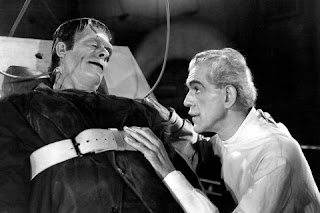George was born on August 16, 1899 in the tiny town of Weed in Otero County in what was once called the New Mexico Territory. As a youngster, George grew up in another tiny town, Cross Cut, Texas - south of the cattle towns of Ft. Worth and Abilene. As he became a teenager, George decided that he cared not at all for being a bartender nor a cowboy as his father had been. Playing music was what he wanted to do when he grew up.
George picked up a fiddle and a guitar and by the age of twelve, was a favorite performer at cowboy dances in Brown County in central Texas. George, of Irish and Cherokee descent, had no formal training in learning how to play his musical instruments. He listened and watched and became a pretty fair fiddler and guitarist. In 1928, George was performing on the radio over in the big city of El Paso. Still anchored to his father’s ranch, George made the fateful decision to leave home.
Off he went out to Hollywood as a member of the Arizona Wranglers, joining his cousin “Cactus Mack” in the group, which sung on radio programs and performed at rodeos in the Southwest. As George began to learn more about music, he began to write and perform his own compositions.
To help pay the bills, George joined Hoot Gibson’s Rodeo. His friends and colleagues penned the name of “Pee Wee” on Georgia during his brief career as a rodeo rider with Hoot Gibson’s Rodeo show.
George then made a career changing, life altering decision. He left his musical career and took a role with Gibson in a western called, “Wild Horse” in 1931. It was during the year 1932 in the darkest days of the Great Depression when George got a minor role in a twelve-chapter serial movie, The Hurricane Express, starring a very young John Wayne. (above)
For most of the 1930s, George could be seen in a long litany of western movies, playing mostly villains, henchmen and cattle rustlers. In that decade, George appeared in at least 112 movies, mostly westerns, but did have a minor role in the iconic science fiction serial Flash Gordon.
In the 1940s, George’s career as a cowboy in the movies, with occasional appearance in a war movie or crime dramas, continued for about 75 more pictures until he made another career changing move.
George with Boris Karloff
George accepted Universal Studios’ offer for a completely new role for him. Playing opposite John Carradine as Dracula and Lon Chaney, Jr. as the Wolfman and Boris Karloff as Dr. Niemann, George starred in the title role as Hollywood’s second Frankenstein monster in 1944's “House of Frankenstein” another of Universal’s classic series of monster movies.
George reprised his role the following year joining Chaney and Carradine in a sequel, “House of Dracula.” In 1948, George returned to the big screen as he scared all of the wits of Lou Costello and Bud Abbott in “Abbott and Costello Meet Frankenstein.” Lon Chaney, Jr. returned as the Wolf Man and Hollywood’s number one Dracula, Bela Lugosi joined George in Hollywood’s most classic trio of monsters.
As the 1940s came to end, George continued to work often in films, but as television began to rise in popularity, George began to accept roles on the small screen. In one of earliest roles, George portrayed “Butch Cavendish,” (left) the evil. fiendish villain, who killed a party of Texas Rangers, except “John Reed,” who managed to survive the attack and become “The Lone Ranger.” George repeated his role for seven more episodes as the masked man’s, most wanted antagonist.
Appearing in episodes of The Cisco Kid, Kit Carson, Judge Roy Bean, The Restless gun, Wyatt Earp and Annie Oakley, George, in high demand as a character actor in western tv shows which dominated the air waves in the 1950s, finally found his longest and most well known role.
George was invited to audition for the role of Sam Noonan on a highly popular western show. He would play that role for a dozen plus years until his death in 1973.
For you see, the once rancher and son of a bartender, who left Texas behind to become a musician and a singer, took on the role of Sam, the bartender, in TV’s most successful western ever, Gunsmoke.
As the most famous bartender in television, the strong silent and steadfast Sam, George Glenn Strange from behind the bar kept order in the Long Branch Saloon until Matt Dillon, Festus or a host of deputies arrived to put an end the ruckuses.
The man whom his friends once called “Pee Wee,” was actually six foot five inches tall and weighed in at more than 200 pounds - a size which made him an excellent choice to play Dr. Frankenstein’s monster.
Glenn George Strange, "Sam Noonan," Gunsmoke
In his forty-four years in movies and television, Glenn Strange played good guys, bad guys, mostly bad guys in as many as 500 roles.
A television’s most famous bartender, Sam Noonan poured thousands of shots of whiskey. In reality, Glenn Strange was teatotaler and rarely drank any alcohol.
The man, who was described as part Irish and one-eighth Cherokee, was more than just part Indian. After spending a career portraying cowboys fighting Indians, Glenn Strange was the seventh great grandson of John Rolfe of Virginia, and his Pamunkey Indian bride, Pocohantas.
Regrettably, Glenn Strange has no ties to our area, but he is definitely a piece of our past. I hope you enjoyed my new style of telling you stories under the banner of “Once Upon an Anecdote.” As a fifth generation Braswell story teller, I can promise you there will be more interesting and fascinating stories to come. And yes, many of them will relate to Laurens County and East Central Georgia.





Comments